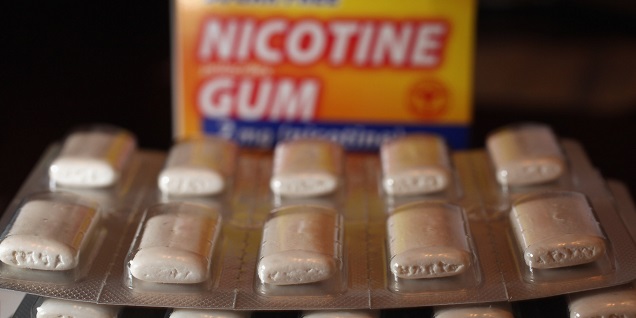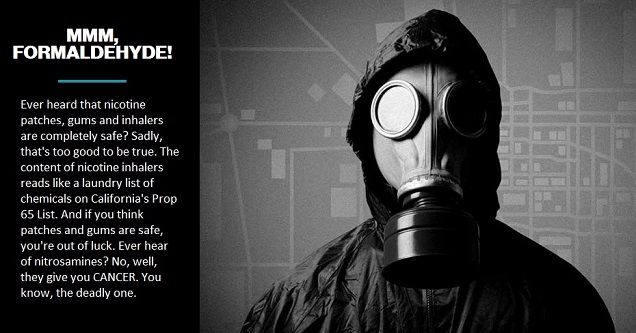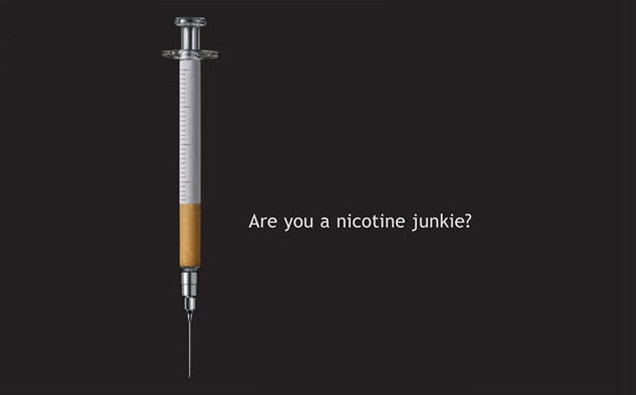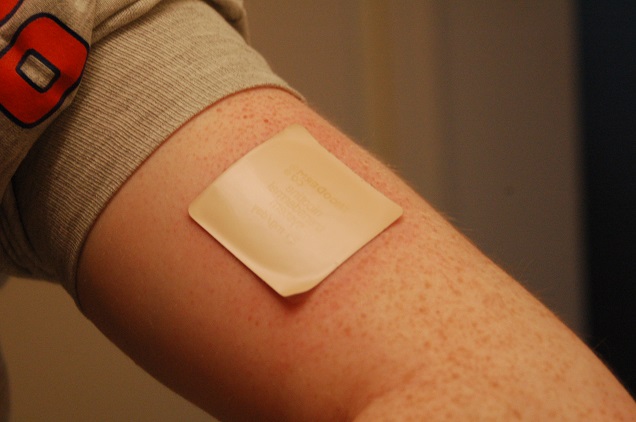
They seemed like a great idea. “It’s completely safe,” they said, “and it helps smokers move away from something that stands a substantial chance of killing them.” And politicians and the medical establishment – probably suckered in by backhanded bribes from Big Pharma – embraced them wholeheartedly. Soon, they were available over-the-counter: “we’ll make them as easily available as possible, to maximize the number of quitters,” they thought.
The intention is admirable, but in reality it’s hopelessly misguided.
Nicotine replacement therapy (NRT) isn’t as benign as Big Pharma wants you to believe. They may have suckered politicians, doctors and scientists into supporting their trade in an addictive drug, but with my powers of cherry-picking, misrepresentation and lies of omission, I can reveal the truth: NRT is a serious threat to public health.
They Contain Carcinogens and Harmful Chemicals

The Big Pharma companies who promote these insidious products want you to think they’re completely safe, but they’re wrong. Nicotine patches, nicotine gums and inhalers contain tobacco-specific nitrosamines, which are potent carcinogens (that means they can give you cancer). As well as these nitrosamines, nicotine inhalers contain formaldehyde, acetaldehyde, o-methylbenzaldehyde, cadmium, nickel and lead. The money-hungry companies who sell these death-sticks apparently believe that huffing lead and embalming fluid is a good idea.
And don’t listen to all that “trace amounts,” and “the dose makes the poison” hokum: it’s spin and propaganda, plain and simple. Paracelsus was a quack.
They Contain Nicotine, A Highly Addictive Substance

Pharma shills will tell you that nicotine, outside of smoke, isn’t particularly addictive. They’ve even managed to convince the FDA to remove the addictiveness warning from nicotine replacement therapy products. But all their “data” and “science” mean nothing if you trust your instincts instead of the facts.
Think about it this way. What’s the addictive chemical in cigarettes? Nicotine. Everybody knows that. And smoking is really hard to kick, so that means nicotine is ridiculously addictive. Many people say it’s more addictive than heroin and cocaine, and people wouldn’t just say that for no reason. Bear in mind that some of these people are doctors. Don’t believe the marketing spiel about the synergistic interactions with other components of tobacco smoke having an important role to play: nicotine is addictive and addictive things are bad.
Most NRT Users Don’t Quit: They Still Smoke

Big Pharma wants you to believe that NRT is used for quitting smoking, but yet again, the reality doesn’t match up to their marketing spiel. In the real world, almost all smokers who try patches, gums and inhalers continue to smoke. Rather than quitting, about 93 % of smokers who try NRT just become “dual users,” or even just go right back to smoking. Bear in mind that NRT can be used in smoke-free areas, so most smokers are probably just slapping the occasional patch on their arms or chain-chewing gum in order to get their filthy nicotine fix in smoke-free areas.
Why would these companies continue peddling ineffective products? Why claim they help smokers quit when the vast majority will fail? Because quitters cease to be customers. Do you really think that multi-national corporations are just selling these addictive drugs in order to help smokers become nicotine-free forever? Of course they aren’t. They want two things: products that are ineffective for most smokers – so they’ll relapse to smoking and probably come back and try NRT again in the future – and products that are highly addictive – so many smokers get hooked on their products and keep handing over their money to feed their addiction. It’s a business; not a benevolent charity.
Nicotine Gums and Patches Come in Sweet Flavors

Like the tobacco companies of old, Big Pharma knows that if smokers do end up quitting smoking and nicotine entirely, they would slowly run out of customers. The multi-billion dollar industry wouldn’t let this happen.
After undoubtedly reading the leaked tobacco industry documents, they decided to start offering their products in a wide range of flavors that are appealing to youth. Nicotine gums are available in flavors such as “Fruit Chill” and “Cinnamon Surge.” Now, ask yourself: does this sound like the sort of thing an adult smoker would want, or like the sort of thing you’d find on a pack of sweets aimed at children? The answer is obvious. If they were marketing to smokers they should make them taste like stale ashtrays or burning ass-hair or something. They’re clearly shooting for the youth market.
As if that wasn’t transparent enough, the corporations selling these ineffective, addictive, sweet-flavored monstrosities have even made them into lozenges – which look just like sweets – in the hopes of attracting more youth non-smokers. GlaxoSmithKline calls them “a discreet way” to get your nicotine fix and adds that they’re “practically unnoticeable.” It might be couched in terms of “quitting smoking,” but any school-kid reading this will think “I could probably use those in class and nobody would know.” It’s an epidemic waiting to happen.
Scary Numbers of Teens Are Using NRT, and Not to Quit Smoking!

About that epidemic: there’s no need to wait. A study published in JAMA Pediatrics traced the roots of this disturbing trend, finding that about half of students said it would be easy for them to get their hands on NRT, and that 18 percent of users has never smoked conventional cigarettes. Finally, as if this needed clarification given what we’ve just learned, a massive three-quarters of youth NRT users weren’t doing so to quit smoking.
They’re probably more interested in the oh-so-hip fruit flavored chewing gum or the candy-like lozenges, but – need we remind you – any nicotine use in adolescents could have long-term consequences for their developing brains. What do you mean we only have evidence for that from studies of rats? What do you mean it’s better than them trying cigarettes? You’re one of those Big Pharma spin machines, aren’t you?
You might rush to defend relatively harmless experimentation, but what about this story: because Big Pharma has such a stranglehold on society, their addictive and kid-appealing products are actually given out to school-children, and at least one child has collapsed and nearly died as a result. In a frenzy of consumption typical of a nicotine addict, he consumed 45 sticks of nicotine gum in less than half an hour. He collapsed and had to be rushed to hospital. But the companies selling these things insist they’re “safe.”
Nicotine Patches and Gums Poison Children

Yet again, these problems are not confined to isolated cases. There were over 1,300 poisonings (p154) from NRT products in 2014 alone, and about 64 percent of them were in children under the age of 12. Since NRT products are often sold in child-friendly flavors, are often indistinguishable from bubble gum or sweets, and they don’t have child-proof packaging, this shouldn’t come as much of a surprise. And if you think that figure was a one-off, you’re wrong: there were almost 1,400 poisonings in 2013 (p220) and about the same number in 2012 (p245). In other words, this is a problem that’s showing no signs of letting up.
Why NRT is a Threat to Public Health
So putting this all together: NRT products are sold by unscrupulous companies, are designed to deliver a highly addictive chemical, contain several carcinogenic and toxic contaminants, are attracting non-smoking children into addiction through the use of clever marketing and child-friendly flavors, are responsible for thousands of poisonings each year, and the majority of smokers who use them for what’s supposedly their intended purpose aren’t even successful in quitting smoking. If this isn’t a threat to public health, I don’t know what is.
Sanity Returns
Well, that was terribly silly wasn’t it? By omitting or brushing over crucial bits of information – for example, the unimaginably tiny quantities of the harmful chemicals present or the fact that most youth who tried NRT didn’t become regular users – paying attention to the smokers who it failed for rather than their benefits in comparison to unassisted quitting, making unfounded leaps from the addictiveness of smoking to the addictiveness of nicotine on its own and wildly speculating that the intent of making something available in sweet flavors is a nefarious plot to lure non-smoking youth into addiction, I managed to make a big fuss about nothing.
But nobody would really do anything that ludicrous and dangerous when discussing a potentially life-saving product, would they? No… of course not. That would be horrendously irresponsible.

